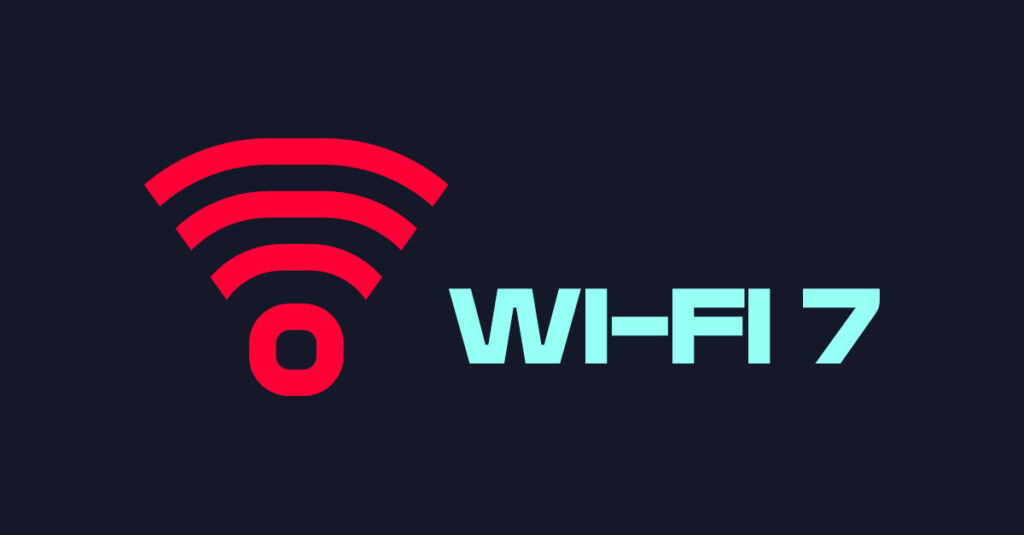
What Wi-Fi 7 Can Do for Your Home Network
19 commentsUpdated on April 4, 2024
Although Wi-Fi 6 and 6E devices are just starting to get popular, the first Wi-Fi 7 routers are already here. So, if you want to be ready for this next-gen Wi-Fi experience, check out what Wi-Fi 7 will mean for your home network over the next few years. Frontier can help get you started with a powerful Wi-Fi 7 router to support your network of devices.
What is Wi-Fi 7?
Wi-Fi 7 is the seventh generation of Wi-Fi. You don’t remember Wi-Fi 1 or Wi-Fi 2, because they didn’t really exist, at least not by that name. Wi-Fi generations used to be known exclusively by archaic strings of letters and numbers, but that changed a few years ago. That happened when the Wi-Fi Alliance—the group responsible for developing the Wi-Fi protocol—renamed IEEE 802.11ax to Wi-Fi 6 (and retroactively renamed Wi-Fi 4 and 5). Technically, Wi-Fi 7 is IEEE 802.11be, but we’ll stick with the easier naming convention.
If you have a family collection of smartphones, laptops, game consoles, smart home tech and all the rest, the devices in your house probably rely on some combination of Wi-Fi 5, Wi-Fi 6 and Wi-Fi 6E. The good news is that all these devices will be compatible with any Wi-Fi 7 router, although they won’t benefit from its more advanced features. So, even if you get a shiny new Wi-Fi 7 router, you won’t have to replace your smartphone just yet.
But if all these Wi-Fi standards are still relevant, what’s the point of Wi-Fi 7? Read on.
Frontier’s got the Wi-Fi 7 router you need for speed
When you’ve got Frontier’s multi-gig internet, you need the right router to get the most out of that amazing speed. Now you can power your home network with the brand new Eero Max 7 router. It’s included with Frontier 5 Gig service.
The Max 7 is made for Frontier multi-gig households with lots of devices and lots of users. This router will enable up to 10 Gig speeds with the latest Wi-Fi 7 technology. Expect more bandwidth, higher Wi-Fi speeds up to 4.3 Gbps, and lower latency.
Level up your gaming, get the most from AR, VR and cloud apps. Work from home with lightning fast speed throughout your home.
With the Max 7, you’ll have two 10 Gigabit Ethernet ports and two 2.5 Gigabit Ethernet ports, allowing for multiple wired connections. Tri-band Wi-Fi 7 will support up to 4.3 Gbps to your Wi-Fi 7 capable devices, with whole home wireless speeds up to 2.5 Gbps. Plus there’s a Smart Home Hub built in which allows you to control all your Matter connected devices through your Eero app.
Frontier multi-gig + Wi-Fi 7 technology: This is your future.
Wi-Fi 7 is faster
Every new generation of Wi-Fi brings faster wireless speeds to your network, at least theoretically. However, because so many factors affect your real-world Wi-Fi speeds, it’s impossible to know exactly how fast your network will be. Still, let’s look at things in general terms.
Wi-Fi 6E, the previous update to the Wi-Fi protocol, has a theoretical maximum bandwidth of 9.6 Gbps and real-world speeds of up to about 2,400 Mbps under ideal conditions. Wi-Fi 7 has the potential to be much faster; it has a theoretical maximum bandwidth of 46.1 Gbps and real-world speeds of up to about 11.5 Gbps under ideal conditions.
To get these faster speeds, Wi-Fi 7 relies on a few neat innovations. Two of the most important are the new 320 MHz channel and 4K-QAM (quadrature amplitude modulation), both of which allow more data to be transmitted at once. (You can read more about them here.)
Another exciting new feature is called Multi-Link Operation (MLO). Until now, Wi-Fi could only connect two devices using a single channel on a single frequency band. With MLO, Wi-Fi 7 will be able to combine multiple channels across different frequency bands into a single connection. This will allow for not only faster bandwidths, but also more efficient data transfer. Your router will be able to select channels that aren’t being used by other devices and ensure a super stable Wi-Fi connection.
Wi-Fi 7 supports more devices, more seamlessly
Wi-Fi 7 also offers features that make it easier to have more devices running on your home network without any issues. MLO is one part of it, but there are others.
Orthogonal Frequency-Division Multiple Access (OFDMA), which was included in Wi-Fi 6, allows several devices to connect using the same channel. Multiple Resource Unit (MRU) functionality in Wi-Fi 7 improves upon it and allows your router to more efficiently divide up a channel between the different devices using it. Similarly, the number of Multi-User, Multiple Input, Multiple Output (MU-MIMO) connections has also been doubled, from 8 to 16.
Combined, all these features mean that if you’ve got lots of smart home devices that don’t need to send that much data all that often. They won’t hog your connection and slow things down for your other more data-hungry devices.
Who will benefit from Wi-Fi 7?
Over the next few years, everyone will benefit from Wi-Fi 7. It enables you to have a faster, more stable home network that supports more devices. In particular:
- If you have a multi-gig fiber connection, Wi-Fi 7 will allow you to get gigabit speed uploads and downloads over your wireless connection.
- If you have lots of devices in your home, Wi-Fi 7 will enable them to operate seamlessly without interfering with each other.
- If you stream games, movies or anything else over your home network, Wi-Fi 7 will make everything run smoother.
What do I need for Wi-Fi 7?
The main thing you’ll need in order to take advantage of Wi-Fi 7 is a new router. Then it’s a matter of updating your smartphone, computer and game consoles as new versions that support Wi-Fi 7 become available. You’ll then be ready to get the most from this next-gen Wi-Fi.
Frontier Fiber is built for the way you live today—and tomorrow
If you’re still on the lookout for the right ultrafast internet connection for streaming, gaming, working from home and running your smart home—all with enough bandwidth for everyone—find out about Frontier Fiber. Frontier Fiber is available in select areas—check here. Then make sure your Wi-Fi network is ready for next-gen performance at gig speed with Frontier’s eero Max 7 router.
Product features may have changed and are subject to change.




Right now, when I try to sign into Wi-Fi the 5G option has the least number of bars, so it rarely works. When will I see this new and improved 7G?
Hi Robert, thanks for the question. The Wi-Fi network you’re seeing with the 5G in the name as an additional network is the 5ghz frequency, this is not the same as the mobile technology of 5G. It is one of the frequencies used by Wi-Fi 7. The reason you may be seeing a lower signal strength compared to the other network at 2.4ghz has to do with the physics of radio waves. Simply put, the longer the wave, the further it travels and the better it penetrates walls. You can sign up here: https://fybr.to/3vdR3LE to be notified when upgrades to Wi-Fi 7 with Eero Max 7 routers become available. ^Michael
Hi Larry, the decision surrounding whether to upgrade your Wi-Fi technology is complicated and depends on your use case. Based on what you’ve shared I would probably say no, your use case doesn’t sound like you would benefit as much as you might by trying to figure out better placement to avoid any of the interference or signal dips that are causing you to see buffering. Streaming video, even at 4K UHD, only requires about 25Mbps of bandwidth, a tiny fraction of the bandwidth you have available even at typical Wi-Fi speeds and ranges. ^Michael
What are the most common interferences in regard to placement of the router?
HI Thomas, we don’t have pricing information for Eero 7 Max for Frontier subscribers available yet but Amazon has started taking orders for this brand-new hardware now that we’re in 2024. You can see their page here: https://fybr.to/3H42YhV.
Thanks for the question about common interference sources, specifically with regard to router placement. This one is potentially complicated but I’ll try to keep it as simple as possible. The radio frequencies used by Wi-Fi microwave and in radio terms micro means small just as it does in other applications. These very small waves are capable of carrying lots of digital information, but because they’re relatively small and weak, they don’t travel very far nor do they travel well through dense materials or metals. In fact, your microwave oven heats food using radio waves in the same frequency range as your Wi-Fi router but at 1000-1500x the power. It contains that in a metal box above your stove or on your kitchen counter, which is pretty wild to think about. As you might imagine, if your Wi-Fi signal is on the other side of any metal appliances or building materials, that will cause issues. Heavy materials like concrete in walls or between floors will have a similar impact.
Active sources of interference can come in the form of other competing Wi-Fi networks or devices in the home, or even other devices that use the same frequency ranges but are not Wi-Fi technology. Bluetooth operates on 2.4ghz and many baby monitors flood 2.4ghz and 5ghz frequencies with audio and video signals that are not Wi-Fi but using the same radio waves. The smallest leak of radio waves from a running microwave oven can also be detrimental to Wi-Fi signals when you consider that just 1/1000th of that signal is likely to be stronger than that of your Wi-Fi network! They key with placement is understanding where any of these physical or active interference sources are in relation to our Wi-Fi access points.
This makes it sound like Wi-Fi, as a technology, is having a rough go! It’s true it has a lot of ‘noise’ to compete against, but the good news is that each subsequent revision of Wi-Fi technology improves every aspect of connectivity. It gets faster, more robust and more fault-tolerant of interference with each revision and Wi-Fi 7 really swings for the fences when it comes to improving the overall wireless experience. Thanks again for the question! ^Michael
As a current customer can I get this WIFI 7 for the advertised price of 59.95/mo.? Or should I cancel my subscription, wait a month and do it then?
Hi Charles, we do not have our pricing strategy available for when the Wi-Fi 7 Eero Max 7 devices start to be deployed to our customers but it’s worth noting this is most likely separate from the monthly service charges. Amazon just started taking orders on Eero Max 7 directly, which you can see here: https://fybr.to/48ddak6. ^Michael
How to I upgrade my equipment? I’m an existing customer
Hi Jason, we haven’t finalized our strategy for delivering and supporting Eero Max 7 for our customers but if you want to get your hands on it sooner Amazon has opened up orders on their site https://fybr.to/3RHvScK. You can sign up for updates on availability through us above! ^Michael
Will the Wi-Fi 7 router work in our area? We have the Frontier router now and I’m not sure what frequency we have. We’re able to stream a few things once in awhile but it’s still buffering at times. We have DirecTV and we have the newest Gemini which is working really well. Please let us know what we should expect to be doing in the near future.
Thank you, Rhoda
Hi Rhoda, Eero Max 7 is a Wi-Fi 7 or 802.11be (7th generation) of Wi-Fi wireless network hardware from Amazon’s Eero brand. We have partnered with them to bring this exciting new technology to our customers. This enhanced and newer wireless technology is backwards compatible with all older Wi-Fi and requires Wi-Fi 7 compatible devices (new and future devices) to take full advantage of its capabilities. It’s not specific to any service and depends on an internet connection. You can sign up for updates from us above! ^Michael
Can i replace my eero 6 with eero 7 ?
Hi Vahhab, thanks for the question. We plan on having options for our customers to upgrade to Eero Max 7 but for now we’re still developing that strategy. Since we’re now in 2024, Amazon has opened orders if you want to get a jump start you can visit their page here: https://fybr.to/3RH2hjr or sign up for availability info from us here: https://fybr.to/3RKg09f. ^Michael
i use several Wi-Fi equipment like 8 camera surveillance system around my house, and I use several monitors for Wi-Fi music with a laptop and android tablets. i have already purchased the 500 Wi fi speed but my cameras still have intermediate connection problem. will this improve my connections
Hi Ben, thanks for this question! It’s a common misconception that “Wi-Fi” and your internet connectivity are interchangeable, but they’re actually different parts of your overall network connectivity. We deliver a fiber optic 500/500 wired connection to your home through an Optical Network Terminal (ONT) and can deliver speeds up to 5x faster than that at increments of 1000/1000, 2000/2000 and 5000/5000 respectively. Your home’s Local Area Network (LAN) connects to share the bandwidth across devices. It sounds like you use primarily, or maybe even exclusively, wireless or Wi-Fi technology. If you’re observing intermittent connectivity issues between some devices over wireless it sounds like you may have interference or range issues. If you are not currently using Wi-Fi mesh technology, it could improve your coverage and signal strength. If you’re already using Wi-Fi mesh technology, you may need to adjust the placement of your access point or perhaps add more to extend coverage. Hope this information helps! ^Michael
What about latency? I have heard that Wi-Fi 7 reduces lag to a theoretical minimum. Will be see improvements there with Frontier? Talking specifically about Wi-Fi 7, as there is no mention about latency in the article.
Hi Francisco, you must be a gamer! You’re correct, Wi-Fi 7, 802.11be will have reduced latency when compared to Wi-Fi 6/6E 802.11ax, but one could argue that theoretical minimums have already been achieved with human reaction time being way slower. Wi-Fi 7 adds about 5ms of latency, and when compared to the 20ms of latency added by Wi-Fi 6, that’s substantial. Unfortunately, even the most elite of gamers have a reaction time closer to 200ms. I’m also a gamer and in denial about this reality because I game over wired Ethernet for the <1ms of latency convinced it makes me better even though it probably doesn't! Thanks for this question! ^Michael
I tried to find out more information on the WIFI 7 and if its available in my area and was transferred 3 times. No one knew what I was talking about. I finally hung up. We have trouble with speed and buffering when we have several devices on. Was hoping to solve that problem, but I guess not with Frontier. Spectrum recently became available in our area, perhaps I’ll see what they have to offer
Hi Mallory, apologies that our support and account services teams don’t have all the information on Wi-Fi 7 just yet. This technology is so new and cutting edge that the official certification for the technology isn’t even complete, that’s slated to happen Q1 of 2024. In the article is a link (https://fybr.to/47oWbKm) where you can sign up for availability updates on our Eero Max 7 hardware from us. You can also check out Amazon’s site for Eero which is allowing orders of the new hardware already https://fybr.to/3TK5nWs. ^Michael